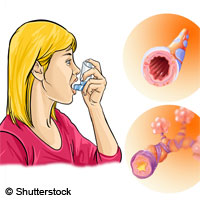EU project to develop tool to fight asthma and pulmonary disease
Researchers and industry experts in Europe have joined forces to deliver an innovative tool targeting the well-being of sufferers of asthma and chronic obstructive pulmonary disease (COPD). The project, called AIRPROM, kicked off in early 2011 and will last for five years. AIRPROM ('Airway disease predicting outcomes through patient specific computational modelling') is backed with EUR 11.7 million under the 'Information and communication technologies' (ICT) Theme of the EU's Seventh Framework Programme (FP7). Airways diseases cost the EU over EUR 56 billion each year; asthma causes some 239,000 deaths in the world each year, and COPD is estimated to be the third leading cause of death worldwide by 2030. Not only are existing treatment methods inadequate, but experts can neither predict how the disease will progress nor how patients will respond to current or future therapies. The AIRPROM project partners will develop computed and physical models of the body's airways system, giving researchers and physicians the support they need to determine how treatments will affect patients. More than 300 million people with asthma and COPD worldwide commonly suffer from damaged, inflamed or obstructed airways. These problems further exacerbate sufferers' breathing difficulties. Treatments that are currently available help patients, but the methods used are not tailor-made for each individual. By not providing unique treatment methods, people may not be receiving the most effective treatment. Research for more advanced and targeted approaches to treatment has been strong in recent years, but more work is needed. This is where the AIRPROM consortium enters the picture. The partners will develop a computed model of the cells in an airway and a physical model of the airways, in order to evaluate how air flows through the lungs and why it becomes obstructed in asthma and COPD sufferers. Coupled with existing data generated by computerised axial tomography (CT) scans and tests measuring lung capacity, these innovative models will give experts the help they need to test novel treatments, which could be developed into unique therapies for patients. This information will be used to create an extensive database linking the characteristics of different pathways to a particular treatment in the future, the researchers say. 'Current treatments for COPD and asthma adopt a "one size fits all" approach,' explains Professor Chris Brightling, a senior research fellow at the University of Leicester in the UK, which is coordinating the AIRPROM project. 'People with these respiratory diseases are therefore missing out on the right treatment to help them manage their condition. These patient-specific models will help us monitor the diseases and how they progress, to make current treatments much more specific and targeted to benefit COPD and asthma patients,' he adds. 'By combining the latest advancements in computational modelling, image analysis, and clinical expertise, we can, for the first time, assess new therapies for asthma and COPD and match them to the right patients.' Commenting on the model and what it means for those who need help, Breda Flood, board member of the European Federation of Allergy and Airways Diseases Patients Association (EFA) and herself an asthma patient, says: 'This new model will help us to visualise activity in our lungs and see how our illness affects our breathing. By gaining an insight into how specific treatments will work, patients will have a better understanding of how to manage their condition in the future.' AIRPROM is part of the VPH NOE ('Virtual physiological human network of excellence') project, which has clinched EUR 8 million under FP7. AIRPROM partners are from Belgium, France, Germany, Hungary, Italy, the Netherlands, Poland, Spain, Sweden, Switzerland and the United Kingdom. For more information, please visit: AIRPROM project factsheet on CORDIS, click: https://cordis.europa.eu/project/id/270194 NOE: http://www.vph-noe.eu/(opens in new window) ICT Research in FP7: http://cordis.europa.eu/fp7/ict/(opens in new window) University of Leicester: http://www2.le.ac.uk/(opens in new window)
Countries
United Kingdom



